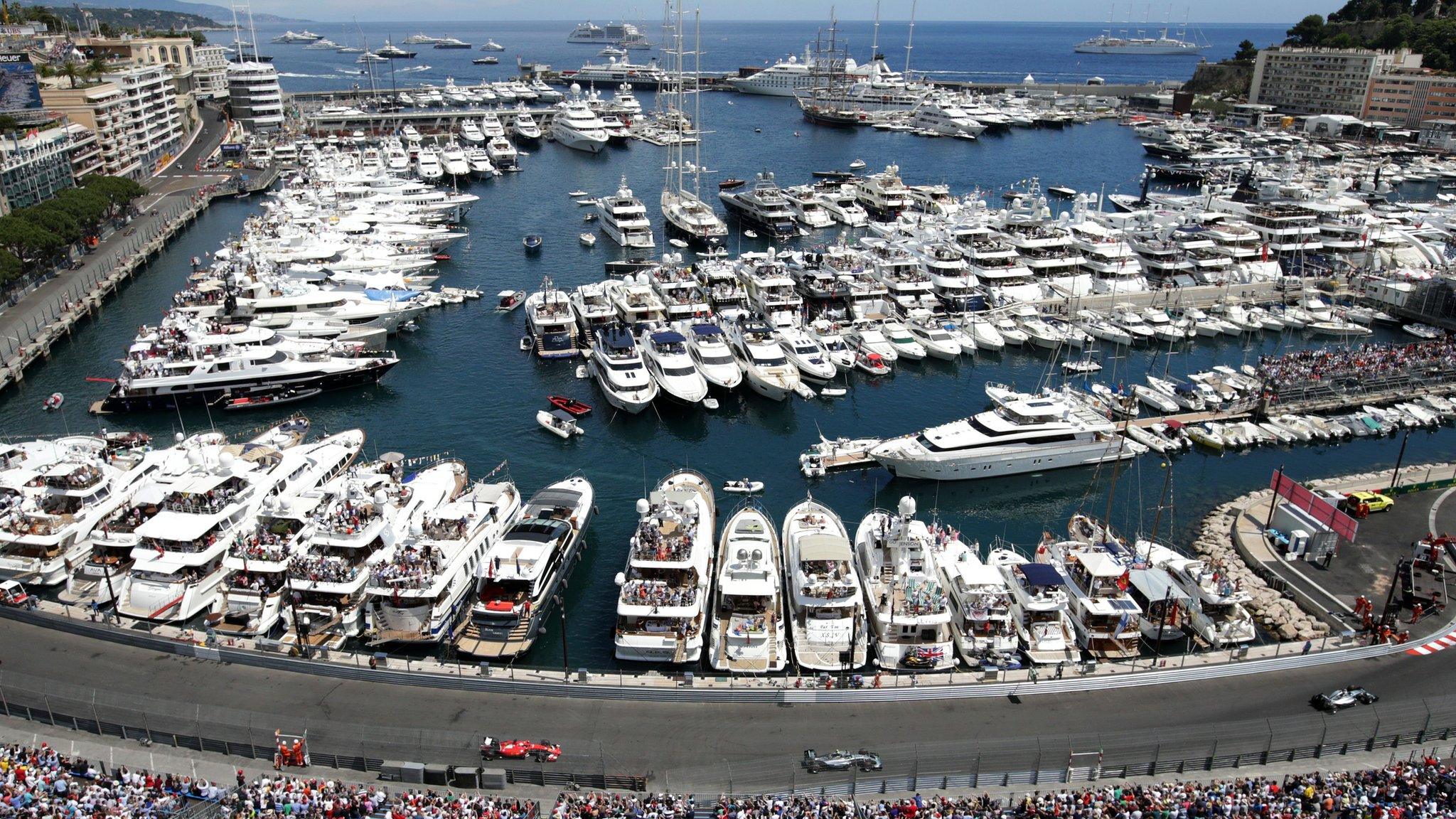Monaco GP: ‘I saw Senna’s glove - he’d worn through it’
- Published
Monaco GP: Chris Rea shares his Formula 1 memories
What type of F1 fan are you?
Imagine for a moment you are privileged enough to be on your way to Monaco to witness F1's greatest race in any way you choose. How do you do it?
Standing on one of Monte Carlo's neoclassical verandas overlooking Casino Square - champagne flute in hand?
Maybe take in some lobster and fine wine as the cars race by at any given restaurant lining the circuit?
Perhaps the Paddock Club, for a grandstand seat and a place in the harbour at the Monaco Yacht Club....
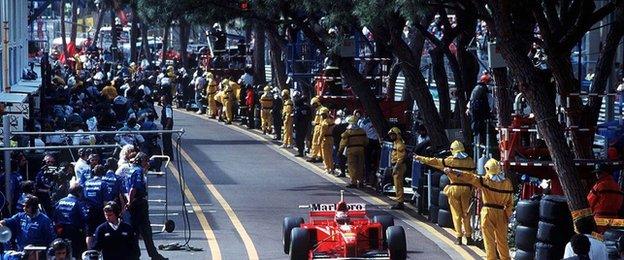
Or being bent over the boiling exhaust of a Formula 1 car whilst wearing a race suit in 80-degree heat?
"I got to wear me own suit and helmet in the garage. I really didn't want to do the VIP thing, so I was in charge of Eddie Irvine's right-rear tyre," remembers Jordan mechanic, and multi-million album-selling, car-themed singer-songwriter Chris Rea. "I did it a few times, but the only time it was hard was at Monaco."
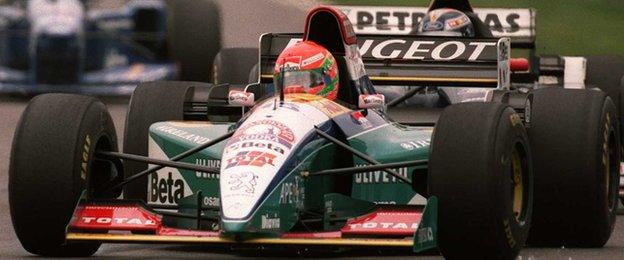
Rea worked on Eddie Irvine's 1995 Jordan Peugeot
It's the 1995 Monaco Grand Prix and Eddie Irvine is returning to the pits with a problem with his right-rear wheel. "My wheel. It was very warm and it's quite a way to run in that gear, probably because I had a terrible hangover.
"Thank you, Eddie Jordan."
For the opportunity. And the hangover.
How the passion was ignited
And it was Monaco where it all began for Rea. But not amongst the F1 and entertainment world's cognoscenti. Like it does for everyone. At home in front of the telly.
"It was Sunday afternoon, a very small broadcast live from Monte Carlo - and Stirling Moss was leaving everybody for dead and as Moss went by as leader, down at bottom of the hill and you'd see these strange little things, and you says to your dad: "what are them?" And he'd say: 'squale' - sharks.
"I was only about eight. 'What's the colour?' I say, and he gets his wine, and he says: 'Blood red, son, blood red.'
"'And who's that driver?' He's like a benign Darth Vader with his modern helmet on, and his name is Wolfgang Alexander von Trips, and he lives in a castle.
"That was it. After that night there was nothing else than the shark nose Ferrari."

The Ferrari which inspired a life of passion for motorsport
But it would be years before Rea turned a passion for F1 and Von Trips into the reality that he could witness at first hand…
"When you grow up… that area of your life has gone - as if you have concussion, because you can't afford it."
It wasn't money, or fame and the access that comes with it that handed Rea an epiphany which would lead him to witness some of F1's greatest moments with his own eyes.
"Many years later you're walking though Cologne on your day off from the arena, and around the corner you see this museum for Wolfgang von Trips. They just got all this stuff down from the top floor, including a box with tins of film - of all his holiday films from 1957 to 1960.
"I hadn't seen footage of Von Trips ever before. It's of him picking his apples in the castle and backstage at every major race. It had never been seen before and they let me have it, which is where I got the boy's dreams idea."
As a way of sharing this access to Von Trips' archive and to celebrate one of F1's most iconic drivers - who was tragically killed at Monza in 1961 along with 15 spectators in one of the sport's darkest moments - Rea has rereleased his double-album and DVD La Passione 20 years after "too many people got involved the first time around".
It now includes the footage that was handed to him in Von Trips' home town, and which took Rea on an F1 odyssey from a dusty museum's loft to Eddie Irvine's white hot exhaust pipe.
The ultimate man-cave
What Rea remembers and has collected along the way competes for wall space with what he achieved in music.
Rea's demo studio at his home sees walls lined with guitars gifted by Paul McCartney and The Smiths' Johnny Marr, as well as what seems like hundreds of his own - including a beguiling orange Fender Stratocaster ("that's the one I wrote Road To Hell on").
But with the tools of a trade that has earned Rea a global profile for decades hang the humble achievements and notable failures of a racing career - pictures of him driving in various amateur meetings with the Historic Racing Drivers' Club, including a win at Donington and pictures of his current car of choice - a police-themed Morris Minor.
Plus a bent piston from a Porsche he was driving at Monaco one year, damaged after missing a gear on his way to Rascasse corner.
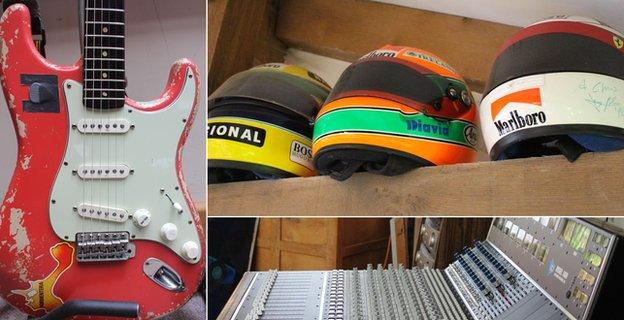
Rea keeps a lot of what he has picked up from the pitlane over the years in his studio, including the helmets of Ayrton Senna, Eddie Irvine and Jean Alesi. And, left, his Road To Hell guitar
"I think I've lost that ability to slow things down - that ability drivers have to calculate what's coming by you at tremendous speed. I used to have it. But I had to pull into the pits the other day - it was wet and I was getting in the way [of the other cars]."
But it's that intuitive sense and skill where the world of motor racing and music collide - where man and machine intertwine to produce something that can never be manufactured. And often never repeated.
"I played at gig at the Montreax Jazz Festival once and on a song called It's All Gone - I had to do free-form slide solo. It's the best thing I've ever done - because I wasn't thinking about it. I've even watched it on YouTube and I've thought: 'I can't do that.'

A mid-'90s F1 steering wheel - found in a box of CDs
"It's like watching a qualifying lap - things you got away with when you were really on the edge. People tell me I've done it again, but I don't think so. It always happens on a wet night in Dresden. If I knew someone was filming it I'd fall to bits."
Why Senna was the best
One man who achieved a qualifying lap that he couldn't possibly explain was Ayrton Senna after his "out of body experience" in 1988. But, like so many of the great drivers, it was when the Brazilian legend was not in the best machinery that his talent shined through. And it's Monaco again where Rea takes one of his fondest F1 memories.
"We were doing a gig. Senna used to gain a second on everyone at Loews hairpin. It was in first gear, it was all mechanical. He used to gain a second on everybody else there.
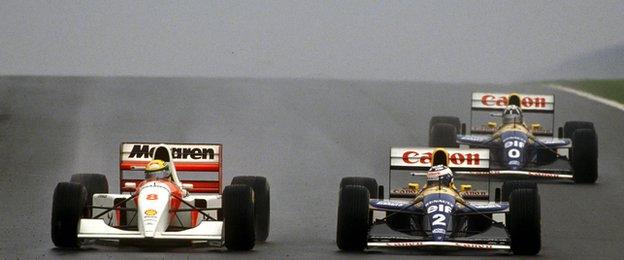
Ayrton Senna during his mesmerising performance at a wet Doninton in 1993
"It's my favourite McLaren year, with the MP4/8 [the first car for years to lose McLaren its prowess in the filed and trail behind the emerging Williams Renaults]. To watch senna inside was amazing. Someone showed me his glove after Monaco - he'd worn through his glove.
"I came home with fencing marks on my face from Donington in 1993," another iconic Senna performance in under-powered machinery and in torrential conditions.
"I stood there for the whole race. He would drive through rivers - I don't know how it did that."
Modern F1 is in a mess
While it might not be surprising to hear that a man who saw Senna and played at F1 during the '90s feels less connected with the sport these days, it gives more credence to the argument something needs to change in the sport.
"Look at Formula 1 now - it's Scalextric. It doesn't look now like what viciously turned people like me on - watching it, thinking: 'I can't do that. Guys with no Armco, but trees, telegraph posts… Cars that were only mechanical. It made it more special.
Two young lads asked me about a 1996 YouTube video of Ferraris doing tests. They didn't remember it - they wanted to know what the hell it was, because they couldn't get over the scream of them cars going past 16,000 rpm, with V12 engines.
"That's not there now. Instead it's that drone. The cars all sound like an out of tune saxophone. [F1's] in a hell of a mess now.
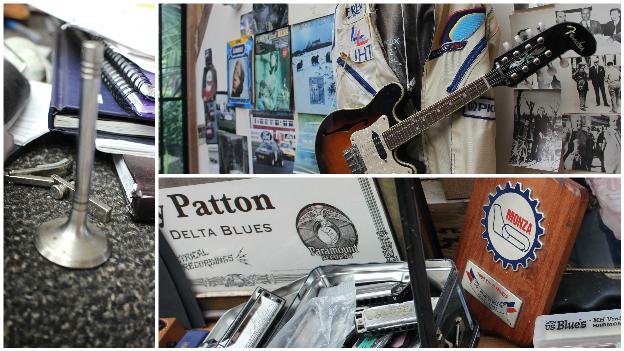
A bent engine valve from Rea's Porsche he raced at Monaco sits amongst the harmonicas and rare guitars
They all go up each other's bums - rules are made by scientists and it doesn't relate to the public."
There's always Ferrari, right?
And what of Rea's beloved Ferrari? The red cars that drew him into the dream 55 years ago? Their mini-revival fading by the race.
"They would try so hard. They would turn up with something so amazing, but then it would break down. Which is so Italian.
"But a lot of Ferrari owners are billionaires these days. And you kind of lose some of that mad men in a village outside of Modena trying to win.
"You can't have F1 without Ferrari - you just can't have it. It's part of the theme that is the red car, and a lot of it is to do with the colour. If a kid falls in love with Ferrari this weekend, when he eventually buys one it'll be red. And when he gets older it'll be metallic red - and he'll have a disguise on when he's driving it so no one recognises him."
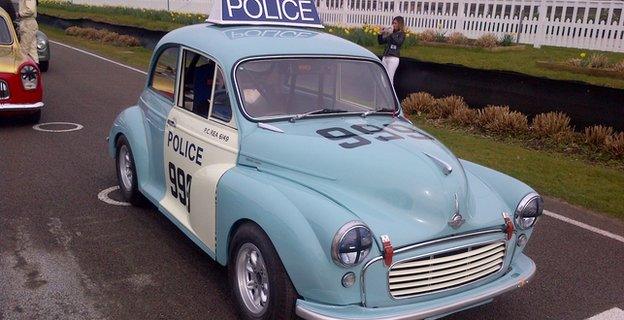
Rea's Morris Minor police car - complete with 'PC Rea' naming on the door
Rea smiles… his humour possibly anecdotal.
"I've given up my Ferrari - the idea of going through my village in a 488… You can't drive them on English roads.
"I had an F12, but I had a lot of trouble with it. The main trouble was how big the bloody things are. I used to say to Luca [de Montezemolo, ex Ferrari president], 'When can we have smaller car? Instead of this battleship.'
For more than 60 years the paddock, and every veranda that lines the Monte Carlo Formula 1 circuit overflows with the rich and famous - attracted by the fine champagne, dining, bobbing yachts and gentle mistral of the Cote D'Azur, as well as maybe a few loud cars disturbing the networking.
But one household name, whose memories involve old steering wheels, helmets and engine parts in a shed, was there for one thing: the racing.
What kind of F1 fan is Chris Rea? A real one.
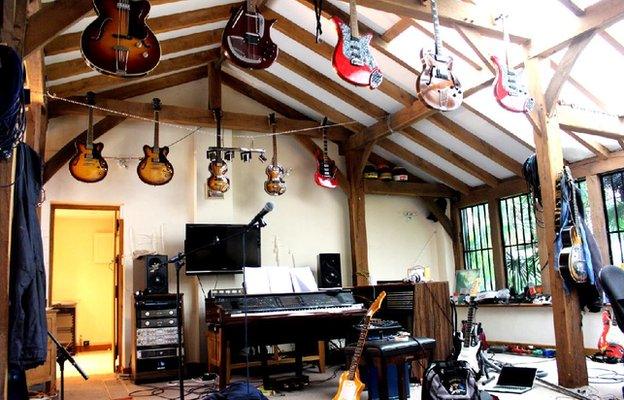
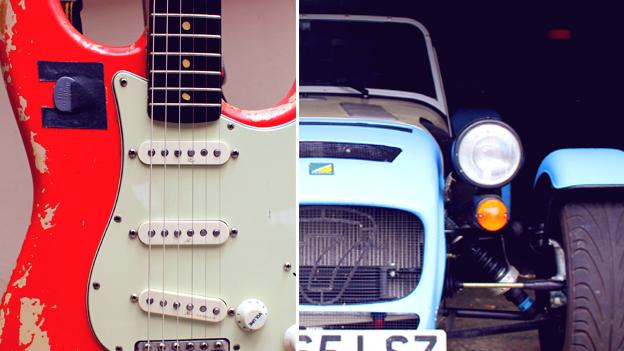
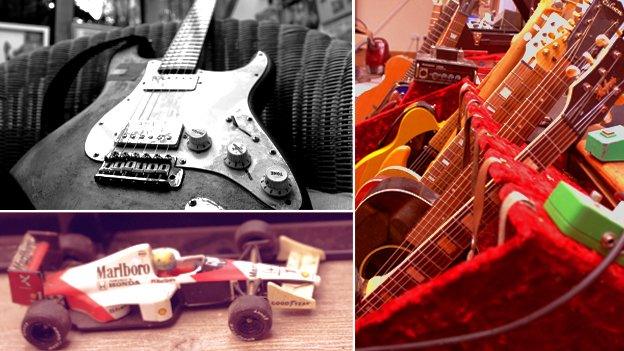
- Published24 May 2016
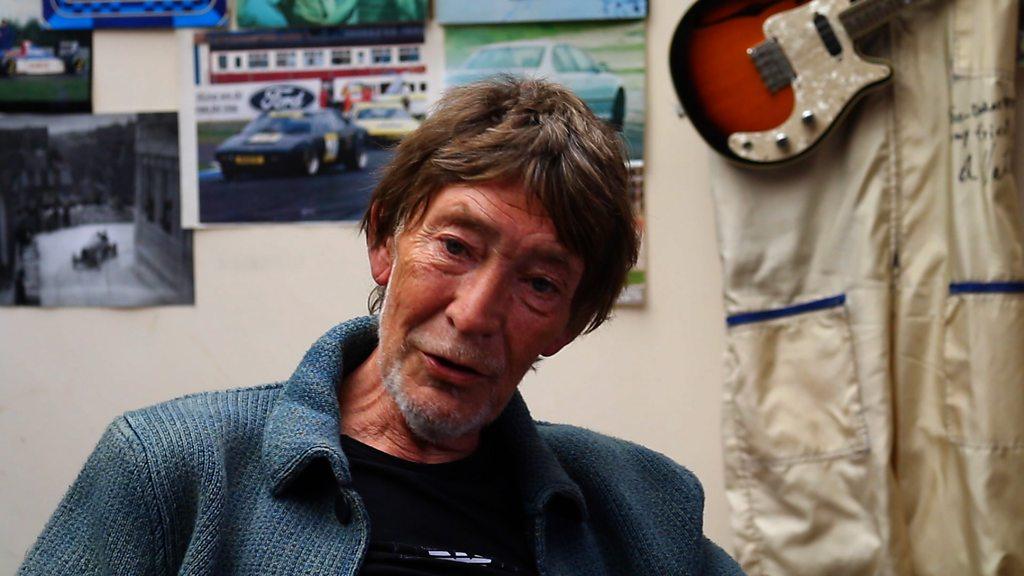
- Published24 May 2016
